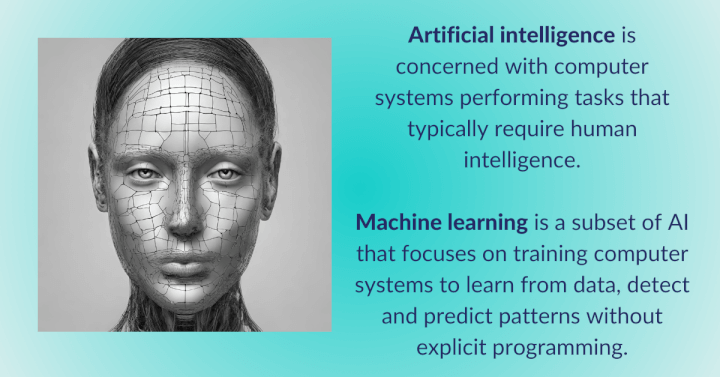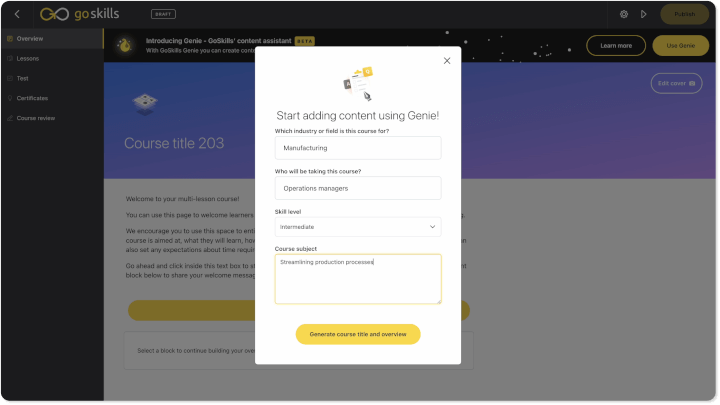Artificial Intelligence (AI) and Machine Learning (ML) might have differences, but they often work together to transform a business. Whether used to enhance an existing capability or introduce a new one, AI and ML have long provided answers for organizations that seek to fix common problems, perform tasks better, or pull off an epic breakthrough. Today, AI and ML permeate nearly every aspect of a business – from customer service and sales to product design and staff training.
Any company with a digital footprint (think email, browsers, and search engines) already uses either technology – or both – in some form or another. However, merely using every “smart” product on the shelf won’t necessarily deliver the business outcomes you hope for. ML and AI now constitute a huge market, which Statista has projected to reach nearly US$740 billion by 2030. Obviously, not all solutions available in that ecosystem might be relevant to your company. Moreover, not every relevant solution might even be worth adopting, given the puzzling range of options to choose from.
The question then boils down to which AI or ML-driven solutions would deliver optimal, cost-efficient benefits for your business. Here are some tips to get you started.
AI and machine learning 101
First, let’s deal with the elephant in the room, which is what AI and ML are and how they differ from each other.
While very similar and tightly linked, AI and ML are distinct concepts. You won’t always get away with interchanging them every chance you get. Simply put, artificial intelligence encompasses a very broad field of which machine learning is just a subset. Bottom line: ML is big but AI is bigger.
Artificial intelligence refers to the field of information technology focusing on hardware and software systems capable of performing tasks that typically require human intelligence. These tasks include those that rely on perception, reasoning, analysis, learning, problem-solving, and artifact (text, image, sound, etc.) generation.
On the other hand, machine learning is a major subset of AI that focuses on training computer systems to learn from data, detect patterns, and formulate autonomous predictions without explicit programming. ML uses algorithms to process training data into progressively refined models that can be used to perform specific tasks.

AI and ML have been deployed in many applications, including gaming, image processing, speech recognition, language translation, recommendation engines, chatbots, autonomous vehicles, fraud detection, and medical diagnosis.
Artificial Intelligence
AI encompasses a broad spectrum of intelligent capabilities, including computer vision, natural language processing (NLP), robotics, generative AI, and machine learning. Across the board, AI applications dramatically transform organizations and how they conduct business.
In manufacturing, AI-powered robots improve efficiencies by automating assembly lines. In security, autonomous systems that use computer vision and other sensor technologies help detect unauthorized intrusions and protect sensitive facilities.
Meanwhile, NLP enables machines such as chatbots to process human language and effectively engage customers. In retail, AI systems help brands and consumers personalize the shopping experience through tailored product recommendations. Finally, the widespread adoption of generative AI accelerates the content development process, empowering teams (such as marketing) that rely on content (text, image, video, music, etc.) to achieve strategic goals.
Real-world examples of AI in action
- Google Translate uses artificial neural networks (ANN) to translate text and speech in real-time across more than 130 languages.
- Tesla's Autopilot system uses computer vision, image recognition, and video processing to enable autonomous driving capabilities in its vehicles.
- Siri and Alexa are AI-powered voice assistants that use natural language processing to answer questions, control smart home devices, and perform other tasks.
- Uber is a ride-sharing and delivery app that uses AI to optimize routes, predict demand, and efficiently match riders with available drivers nearby.
- Genie is an AI-powered course authoring tool that helps businesses create custom training courses with greater ease, efficiency, and impact.
- Google Cloud Contact Center AI chatbot can provide businesses with a virtual contact center for customer service support.
- Salesforce Einstein uses predictive analytics, lead scoring, and tailored recommendations to enhance sales and marketing campaigns.
- IBM Watson for Oncology analyzes large volumes of patient records, clinical trial data, and medical literature on cancer to provide diagnostic insights and treatment strategies.
- ChatGPT is a generative AI that can write articles, debug computer programs, compose music, summarize text, and answer questions across multiple subjects.
- Midjourney is a generative AI that can generate images based on natural language descriptions.
- UiPath uses robotic process automation (RPA) to automate repetitive back-office tasks such as those in accounting and enterprise resource planning.

Machine learning
A subfield in AI, machine learning uses algorithms and statistical models to enable a computer system to progressively learn how to perform a specific task better by training on large volumes of dynamic data. ML algorithms analyze data to identify patterns, make autonomous predictions, and continuously improve performance.
ML systems improve their performance over time as they are trained and exposed to more data. Google’s AlphaGo is a good example. Using neural networks and reinforcement learning, AlphaGo trained extensively against computer and human opponents until it mastered the complex Chinese board game called Go and finally defeated the top-ranked human player in 2017. Enrolling in a machine learning course can help you understand the underlying principles and techniques used in such advanced AI systems.
The ability of a machine learning system to continuously learn and adapt makes it a powerful tool for organizations that seek to optimize operations and continuously improve efficiencies.
Many applications of AI extensively use machine learning. These applications include image recognition, natural language processing, and predictive analysis (without human intervention). ML systems have been used in fraud detection, product recommendation, and risk assessment.
Real-world examples of ML in action
- Google Search employs machine learning algorithms to understand user intent and provide relevant search results, continuously learning from user behavior to improve the accuracy of search predictions.
- Netflix uses ML to analyze user viewing history and preferences to recommend relevant content. The recommendation system helps users discover movies and TV shows based on their interests.
- Facebook uses machine learning in its facial recognition technology, news feed curation, and targeted advertising.
- Spotify uses ML to build and curate personalized playlists and recommendations based on the user's musical interests, listening history, genre preferences, and engagement behavior.
- Grammarly uses ML algorithms to read, check, and correct grammar, spelling, and punctuation errors. The writing assistant also helps users improve writing style and clarity.
- PathAI uses machine learning to assist pathologists in diagnosing diseases by helping improve accuracy and efficiency.
- Amazon uses ML algorithms to personalize product recommendations, optimize pricing strategies, and predict demand patterns.
- MindBridge AI uses machine learning to analyze financial transactions, detect anomalies, and assist auditors in identifying potential issues.
- Predix provides AI capabilities to businesses in the manufacturing sector. Representing GE's industrial IoT platform, Predix uses machine learning to enhance asset performance management, predictive maintenance, and operational optimization.
Transforming your business with AI and ML
Artificial intelligence has already ushered in a sea change in how organizations manage workplaces, nurture talent, create value, engage markets, and drive growth.
It’s hardly done yet.
According to a 2023 McKinsey report, generative AI alone will turbocharge productivity and potentially boost global corporate profits by as much as US$4.4 trillion annually. This estimate reflects the aggregate impact of AI across business functions such as customer service support, talent recruitment, content creation for sales and marketing, coding software based on natural language prompts, and other critical tasks.
Without a doubt, AI – and all its subfields, including machine learning – will still perform the heavy lifting required in many standard business processes while also helping to blaze the trail for ground-breaking innovation. There are many ways to gain benefits:
- Enhance customer experience
- Streamline operations
- Implement data-driven designs
- Make informed strategic decisions
- Maintain a superb talent pipeline
Companies that smartly leverage AI to gain insights, automate workflows, and improve performance can expect to uncover significant opportunities, remain competitive, and thrive in tomorrow’s economy. However, doing so correctly involves a thorough assessment of your business and its goals, current capabilities, and resources.
Generative AI alone will turbocharge productivity and potentially boost global corporate profits by as much as US$4.4 trillion annually.
Here are some tips to remember:
- Involve leadership and stakeholders.
- Identify and prioritize business challenges and opportunities in your organization and industry.
- Understand ML and AI capabilities by being familiar with relevant AI-driven applications and services.
- Assess the needs and skills of your workforce.
- Make a shortlist of existing AI or ML solutions based on your priorities.
- Conduct dry runs using free trials.
- Measure the impact of deployed solutions.
- Monitor. Select. Improve. Repeat.
Skills training and talent development
Worker enablement is one aspect of your business that you can never go wrong improving with AI. Human talent will still matter despite the rapid ascendance of sophisticated technologies like AI and machine learning as force multipliers in many competitive markets.
Businesses rarely run on auto-pilot, and a steady pipeline of skilled humans must still take charge, make decisions, and lead the way toward strategic growth. Ultimately, achieving business objectives will depend on how well-trained your workforce is.
That is where the rubber meets the road. A McKinsey study noted that companies with effective talent management programs outperform their competitors, and LinkedIn reported that talent development can guide organizations to success in tomorrow’s workplaces. Smart companies know this, which is why the global workplace training market is expected to continue its strong post-pandemic rebound to around US$380 billion in 2023.
The question is, how does your company upskill its human assets?
Final takeaway: the genie in the lamp
Sci-fi icon Arthur Clarke once said,
Any sufficiently advanced technology is indistinguishable from magic.
Like its fabulous namesake, Genie is an able and intuitive assistant that can do wonders for your workplace training programs and learning management system (LMS). But unlike Aladdin’s friendly djinn, who wields powerful magic, Genie uses sophisticated AI built on GoSkills’ databank of award-winning courses and the creative process behind them.
While Genie uses generative AI and software engineering on the back end to build custom training courses, the results you and your learners experience might well be magic. Genie dramatically simplifies the course authoring process, allowing businesses to quickly train employees on any topic, including workplace readiness, customer service, sales, compliance, and specific professional skills.
By design, Genie helps you create highly immersive courses with interactive fun in mind. You can add modular content blocks like quizzes, images, videos, and gamified rewards. Meanwhile, your learners can take courses and build skills on the go via their mobile phones, aligning with their lifestyle and helping meet your training goals faster and more effectively.
Artificial intelligence and machine learning are here to stay. But they won’t replace human talent any time soon. With Genie, you can leverage AI and ML to enhance the capabilities of the one asset that matters most to your business: your people.
Ready to make a difference? Build a course with Genie for free.
Your AI content assistant
Take the guesswork out of course creation with GoSkills Genie.
Discover Genie



